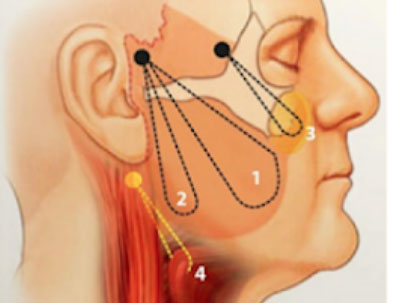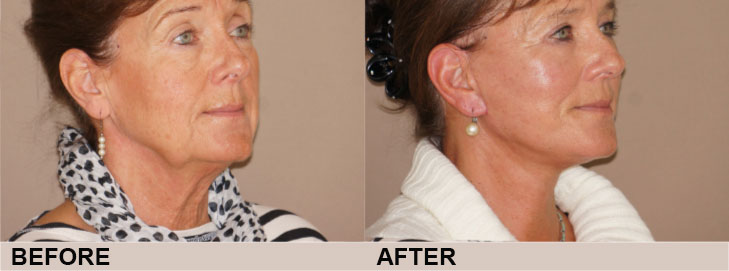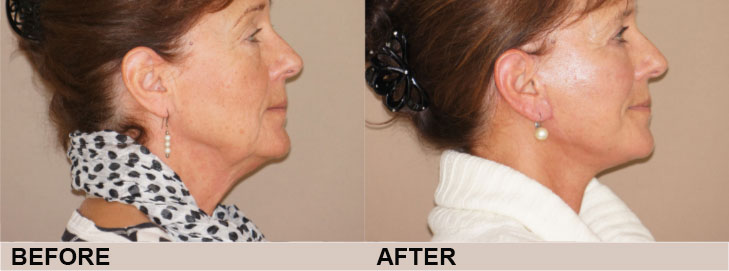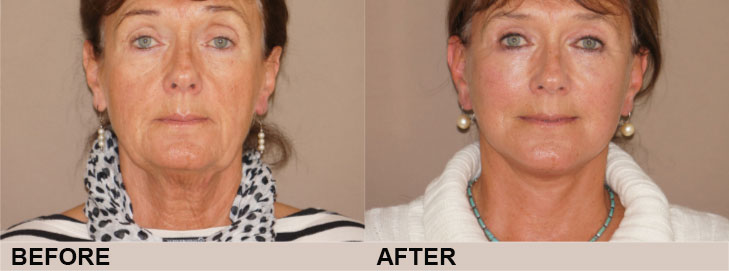What Is The Pave Lift?
Dr Kaye’s PAVE (Peeling-Assisted Volume Enhancing) facelift features several innovations, notably the addition of a fourth "suture" strategically placed under the chin to provide support for the neck. Traditionally, facelifts include three sutures in a MACS (Minimal Access Cranial Suspension) facelift, focusing on the mid-face. Dr Kaye’s introduction of an extra suture, combined with neck liposuction, aims to create a more angled and youthful silhouette.
Having successfully applied this technique to over 200 patients, Dr Kaye noted the continued benefits of the original procedure with a significantly improved aesthetic outcome for the neck.
The Fourth Suture
This new technique developed by Dr Kaye in 2013 was designed to overcome limitations in short-scar facelift surgery by adding a fourth suture. His findings were published in a prestigious German medical journal.
Advancing his facelift technique, Dr Kaye incorporated skin peeling and fat grafting, creating what he terms an "enhanced facelift". This comprehensive approach combines the most effective facial anti-aging techniques in cosmetic surgery into one package.

Facial Fat Grafting
Dr Kaye extracts, or "harvests", fat from one part of the body (common donor areas include the abdomen, thighs, or buttocks) using liposuction, a minimally invasive technique that involves small incisions and a thin tube (cannula) to suction out the fat. The fat is then purified and processed in order to separate impurities, excess fluid and any damaged cells.
The refined fat is then prepared for injection. The purified fat is then strategically transferred to the face to replace lost volume; this can be applied to the lips, cheeks, temples, and tear troughs, softening deep wrinkle or where contouring is needed. The presence of living stem cells in fat offers sustainable results, superior to synthetic fillers.
Properly transplanted, these cells find a new blood supply, living long-term as vascularized tissue in the recipient site, resulting in a natural-looking, plumper, more youthful face. Additionally, stem cells have a rejuvenating effect on the skin, significantly improving the overall skin quality of the patient.
The injected fat integrates with the existing tissues in the facial region. Over time, the transplanted fat establishes a blood supply and becomes a part of the recipient site. This integration contributes to the long-term success of the procedure.
Facial fat grafting is considered a minimally invasive procedure, and the recovery period is generally shorter compared to more extensive surgical interventions. Patients may experience some swelling and bruising at both the donor and injection sites, but this typically subsides within a few days to a couple of weeks.
The results of facial fat grafting are noticeable after the initial swelling goes down, usually within a few weeks. The outcome is natural-looking and can last for several years, as the transplanted fat becomes a permanent part of the treated areas. However, some degree of fat absorption is normal, and touch-up procedures may be recommended to maintain optimal results over time.
Post Facelift Chemical Peel
Within the PAVE facelift concept, post-facelift surgery, a chemical skin peeling is applied to improve the appearance of lines and wrinkles. This combination approach is often employed to optimize the aesthetic outcome of a facelift by addressing additional skin concerns. The chemical peel breaks down layers of skin, revealing fresh, new skin beneath, effectively reducing fine lines, age spots, discoloration, and rejuvenating sun-damaged skin.
The timing of the chemical peel is crucial. It is typically performed once the initial healing from the facelift is complete, and the skin has sufficiently recovered. This is often several weeks to months after the facelift surgery, depending on the extent of the facelift and the patient’s individual healing process.

The choice of the chemical solution depends on the specific skin concerns being addressed. Commonly used chemical peels include alpha hydroxy acids (AHAs), beta hydroxy acids (BHAs), and trichloroacetic acid (TCA). The chemical solution is strategically applied to the skin to stimulate exfoliation and promote the growth of new, healthier skin.
The recovery period for a post-facelift chemical peel is relatively short, with mild redness and peeling that typically resolve within a week or two. Patients may resume regular activities shortly after the procedure, though sun protection is essential during the healing phase. Over the following weeks, patients will notice improvements in skin texture, tone, and clarity.

Dr Kaye’s groundbreaking facelift technique, introduced around 2013, was recognized for its holistic approach, addressing all aspects of the aging face and delivering unparalleled results. The PAVE-Lift, tailored to each patient, is suitable for both younger individuals seeking preventive measures and older individuals seeking rejuvenation. To discover the transformative potential of the PAVE-Lift, contact us at Ocean Clinic, Marbella for a consultation today.

